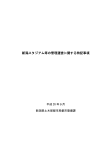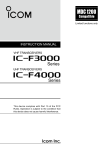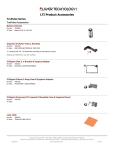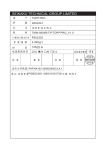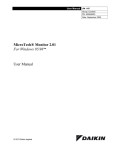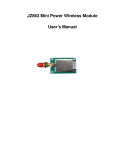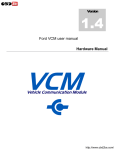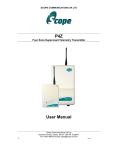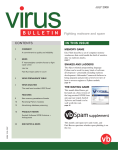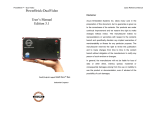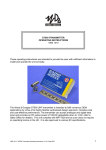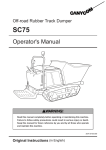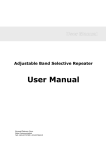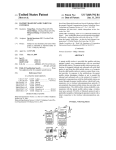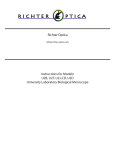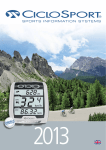Download RM96xx Radio Modem Series User Manual
Transcript
RDT RM96xx Radio Modem Series User Manual Table of Contents Main features and brief description . . . . . . . . . . . . . . . . . . . . . . . . . . . . . . . . . . . . . . . . . . . . . . . . . . . . . 2 Additional Information on Power Supplies/Antennas . . . . . . . . . . . . . . . . . . . . . . . . . . . . . . . . . . . . . . . . 3 Modes of Operation Primary Modes . . . . . . . . . . . . . . . . . . . . . . . . . . . . . . . . . . . . . . . . . . . . . . . . . . . . . . . . . . . . . . . 4 Repeater Modes . . . . . . . . . . . . . . . . . . . . . . . . . . . . . . . . . . . . . . . . . . . . . . . . . . . . . . . . . . . . . . 5 Hayes Mode . . . . . . . . . . . . . . . . . . . . . . . . . . . . . . . . . . . . . . . . . . . . . . . . . . . . . . . . . . . . . . . . . 7 Serial Control Mode . . . . . . . . . . . . . . . . . . . . . . . . . . . . . . . . . . . . . . . . . . . . . . . . . . . . . . . . . . 10 User Control & Configuration User Controls . . . . . . . . . . . . . . . . . . . . . . . . . . . . . . . . . . . . . . . . . . . . . . . . . . . . . . . . . . . . . . . 13 Table of User Settings . . . . . . . . . . . . . . . . . . . . . . . . . . . . . . . . . . . . . . . . . . . . . . . . . . . . . . . . . 14 Explanation of Features . . . . . . . . . . . . . . . . . . . . . . . . . . . . . . . . . . . . . . . . . . . . . . . . . . . . . . . 15 Timing Diagrams . . . . . . . . . . . . . . . . . . . . . . . . . . . . . . . . . . . . . . . . . . . . . . . . . . . . . . . . . . . . . . . . . . Specifications . . . . . . . . . . . . . . . . . . . . . . . . . . . . . . . . . . . . . . . . . . . . . . . . . . . . . . . . . . . . . . . . . . . . Serial Port Connections . . . . . . . . . . . . . . . . . . . . . . . . . . . . . . . . . . . . . . . . . . . . . . . . . . . . . . . . . . . . Softward Release Information . . . . . . . . . . . . . . . . . . . . . . . . . . . . . . . . . . . . . . . . . . . . . . . . . . . . . . . . RDT does not assume any responsibility for the use of the products described. No product patents are implied and RDT reserves the right to change the said products without notice at any time. 1 16 17 18 18 RM96xx Radio Modem Series User Manual Features ● UHF FM Synthesised Radio Transceiver ● Transparent serial data transmission ● ● ● User selectable RF channel, Address and Tx power level RS-232 & RS-485 Serial Data Interfaces ● LED indicators for radio functions, signal strength and serial line status 6 modes of operation including Asynchronous, Modem and Repeater ● Forward Error Correction (FEC) ● Automatic Repeat Request (ARQ) Brief Description The RM96xx Series of Radio Modems are a range of UHF multi-channel transceivers, incorporating a GMSK baseband modem and RS232/RS485 serial data interfaces. As with all RDT Radio Modem products, the RM96xx provides fully transparent operation regardless of the serial data protocol. Over-air speeds up to 16Kbps are achieveable and serial data can be input at various baud rates up to 19,200bps. Access to all user configurable parameters is possible using the on-board switches and operational status is easily monitored using the standard LED indicators. Models currently available include the RM96xx Modem Card for OEM customers, the RM96xxB Aluminium housed model and the RM96xxE & EX, IP67 housed units with integral power supplies. A brief summary of features includes addressing capability, user selectable RF power level and frequency of operation, built-in repeater facility, Forward Error Correction (FEC), Automatic Repeat Request (ARQ), MODBUS compatibility (ASCII & RTU) and Hayes Compatible mode. The RM96xx utilises RDT’s unique multi-channel UHF transceiver which is available as a separate module to OEM customers wishing to take advantage of the superior design, built quality and performance for which our products have a world-wide reputation. Applications include Alarm Systems, Data Acquisition, Remote Metering, Remote Control Systems, Warehousing and Despatch, SCADA, Security Systems, Video Surveillance Systems, Telemetry, Traffic Information and Control Systems etc. The RM96xx products carry the CE mark and meet various UK, European and world-wide radio approval specifications including ETS 300 113, ETS 300 220 AND MPT1329. Details are available upon request. 2 Additional Information Power Supply The RM96xx board requires a 12V d.c. power supply which should be well filtered and regulated. Onboard voltage regulator circuits will maintain a constant supply of voltage to the radio and logic circuits, however, excessive noise, fluctuations and interference on the d.c. supply may cause loss of data. Yellow LEDs indicate minimum acceptable signal, green LEDs indicate excellent signal strengh. Coaxial feeder cable is available in many forms, 50 ohm impedance cable with low loss should always be used, note that 3dB of feeder loss will reduce radiated power by half. In some applications where maximum range is required, directional antennae with gain can compensate for feeder loss provided that the maximum radiated power limit is not exceeded. Antenna Selection The antenna should be designed for use at the operating frequency in the 406-470MHz UHF frequency band. The radio range achieved will be dictated by the land topography between the nodes. Ranges quoted below are for guidance only, distances vary according to terrain and obstructions. In many situations increasing atenna height can greatly improve signal strength, and the RSSI test mode can be used for signal strength indicated. Antenna Type Range When low loss RG213/U or UR67 coaxial cables are employed N-type RF connectors should be fitted in conjunction with one of the Antenna Bulkhead Cable Kits to convert from the SMA of BNC socket on the radio module to N-type RF connectors on the coaxial cable. Coverage Gain Mounting Applications /2-Wave Whip 1 km Omnidirectional -3dB Enclosure Mounted Short range general use End-fed Dipole 10 km Omnidirectional 0dB Pole Mounted Medium range general use 8 Element Yagi 20 km Directional (40°) 10dB Pole Mounted Long range, directional 1 Antenna Types 3 Primary Modes of Operation Asynchronous Mode In Asynchronous Mode data arrives through either the RS-232 or RS-485 serial port and is placed in the data buffer. As soon as data is detected in the buffer, the transceiver is switched to transmit mode. Once switched to transmit there will be a short delay (10mS), while the synthesiser locks and the transmitter reaches operating power. The data buffer is then inspected to determine the number of bytes available for transmission in this data packet. A small amount of header information (used internally by the receiving RM96xx) and the data bytes are then transmitted along with a 16 bit CRC. After this packet has completed transmission the data buffer is inspected to see if more data has arrived. If more data is available then the transmission process is repeated. When no more data is available the transceiver is switched to receive mode. When an RM96xx header block containing the appropriate modem address, size of data packet and valid CRC is received then the number of bytes specified in the header block will be read into the data buffer and then output to the RS-232 or RS-485 serial port. Point to point, multidrop and repeater configurations are feasible in this mode. Synchronous Mode In Synchronous Mode timing constraints are imposed on the serial data. This mode is designed to be used in systems such as RTU MODBUS where the end of a message is determined by a gap in the serial data stream of 3.5 characters or more. Data arrives through either the RS-232 or RS-485 serial port and is placed in the data buffer until a gap of 31/2 characters is detected in the serial byte stream. At this point, no more serial data can be accepted until the stored data has been transmitted. The transceiver is then switched to transmit and the contents of the data buffer with a header block are sent as a single data packet. The transceiver is then switched to receive mode. Following reception of a valid header block for synchronous mode, the data packet received is placed into the data buffer. When all the data is in the buffer it is output synchronously to the serial port to ensure no gaps appear in the serial data stream. Point to point and multidrop configurations are feasible in Synchronous Mode. Modem Mode In Modem Mode the transceiver is controlled with the CTS/RTS control line. To transmit, the CTS input must be taken high. When the synthesiser has locked and the transmitter reached operating power the modem will set RTS output high. This signals the user that the RM96xx is now available to accept serial data. Once RTS is raised, the RM96xx will operate in accordance with Asynchronous mode with the exception that the transceiver will stay in transmit until the user lowers CTS. Note: The diagrams of pages 16 & 17 provide timing information on each of the above modes. 4 Repeater Modes From time to time it is necessary to include a repeater in a system for the following reasons:• To extend range • To circumvent obstacles • Achieving a radio link where circumstances dicate the use of less efficient antennas A system using a repeater is inherently more complex than one without and it is recommended that first time users may wish to discuss the details of system operation with their modem supplier. Repeater Modes The RM96xx series modems have three repeater modes, Standard, Repeat All and Automatic Repeat. These are selected by the normal programming method with the rotary switch in position 3 and using DIL switches 4, 5, 6 and 7. Standard Repeater In the Standard Repeater mode all RM96xx units within the system must be set to the same address. The base unit is configured as a standard unit, the repeater is set to 'Standard Repeater' and the remote units must be set to 'Repeater Remote' (see page 14 for switch settings). The base unit transmits data with a standard header block. To avoid unneccesary interference and the possibility of the remote units interpreting the base station transmissions, the remote units will not accept messages with the standard header block. When the repeater receives data from the base unit, the header block is changed prior to re-transmission so that the remote units will recognise the transmission. In the same manner, a remote unit can only transmit data back to the base station via the repeater which changes the header block to the standard acceptable by the base unit. Standard Repeater PC Serial I/O RM96xx Address 0 RM96xx Standard Repeater Address 0 RM96xx Repeater Remote Address 0 Serial I/O RM96xx Repeater Remote Address 0 Serial I/O RM96xx Repeater Remote Address 0 Serial I/O RM96xx Repeater Remote Address 0 Serial I/O Notes An RM96xx in Standard Repeater Mode will receive data from normal RM96xx units or from Repeater Remote Units providing they are set to the same address. A normal RM96xx unit will not receive messages directly from a Repeater Remote. A Repeater Remote unit will not receive messages directly from a normal RM96xx. 5 User Equipment User Equipment User Equipment User Equipment ... repeater modes continued Repeat All Repeat All mode is similar to the Standard Repeater mode with the exception that all valid RM96xx messages are repeated regardless of their address. This permits the use of a base station operating under Serial Control and enables the master to communicate with a specific remote modem rather than broadcasting to all. Repeat All Mode RM96xx Repeater Remote Address 1 Serial I/O User Equipment RM96xx Repeater Remote Address 2 PC Serial I/O RM96xx Serial Control Mode (Variable Address) Serial I/O User Equipment RM96xx Repeat All RM96xx Repeater Remote Address 3 Serial I/O User Equipment Notes An RM96xx in Repeat All Mode will receive data from normal RM96xx units or from Repeater Remote Units regardless of their address. RM96xx Repeater Remote Address 4 A normal RM96xx unit will not receive messages directly from a Repeater Remote. Serial I/O User Equipment A Repeater Remote unit will not receive messages directly from a normal RM96xx. Date sent from the Serial Control RM96xx will only be output at the Repeater Remote which is set to the same address. Automatic Repeat Automatic Repeat mode allows a message to be automatically transmitted along a ‘chain’ of up to 255 repeaters. Each repeater has its address set 1 above its predecessor in the chain. Each unit ‘listens’ for messages from units with addresses 1 below or 1 above their own. (For example unit 6 will listen for messages from 5 and 7). When it receives a message from the higher of lower address it will re-transmit it on its own address. Having transmitted it will disable its receiver for approximately 50mS to prevent reception of the onward transmission. A received message is repeated and output to the selected serial port at the same time. A message input at the serial port of any modem in the chain will travel along the chain in both directions. Customers wishing to use this mode of operation should contact their distributor or RDT technical support for system planning assistance. Automatic Repeater RM96xx Auto-Repeater Address 0 PC Serial I/O A RM96xx Auto-Repeater Address 1 RM96xx Auto-Repeater Address 2 B RM96xx Auto-Repeater Address 3 C Notes An RM96xx in Automatic Repeater Mode will Transmit on its own address and receive on an address 1 higher or 1 lower. i.e. Unit B (above) will transmit with address of ‘1’. Messages from other Automatic Repeaters will be accepted if their address is ‘0’ or ‘2’. All units must be on the same RF channel. After transmitting, an Automatic Repeater will be ‘deaf’ for a pre-defined time period:- (16k RF rate=50mS, 8k RF rate=100mS, 4k RF rate=150mS). This is to prevent unit A hearing the onward tranamission from unit B etc. 6 D Serial I/O User Equipment Hayes Mode Operation Introduction When operating in Hayes Mode, the RM96xx Series of Radio Modem products accepts and responds to a subset of the world industry standard AT command set. This permits a wide variety of systems primarily intended for PSTN operation to function over a dedicated radio link without any changes to the system software. As an intelligent data communications device, the RM96xx analyses and executes commands sent to it as strings of ASCII characters. Provided that an appropriate communications program is active on the computer, you may enter AT commands at the keyboard. Otherwise, you may issue commands through a program in any programming language.The RM96xx returns messages in ASCII string format. Connection Diagram RM96xx 9 Way D-Type DCD RxD TxD CTS RTS GND 1 2 3 8 7 5 DCD RxD TxD CTS RTS GND User Equipment 9 or 25 way D-Type Operational Overview Three system configurations are possible using the RM96xx series in Hayes mode, these are, Point-toPoint, Polled Network and Random Network. Point-to-Point Used in this configuration, a connection can be established which allows bi-directional data transfer between two points. Either point can initiate the connection process. Polled Network In this configuration, the same RF channel is used by all modems in the network. The connection and data communication process is handled by one master modem which connects to each remote modem in turn, communicates using bi-directional data transfer, and then 'hangs-up'. This procedure can then be repeated for all modems within the network. Random Network This configuration is similar to the polled Network with one exception; in addition to the master modem being able to initiate the connection process, any of the remote modems can attempt to connect when the RF channel is free. It should be noted that significant delays in overall system performance are possible when using the Random Network configuration due to the lack of control within the system. 7 ... hayes mode continued System Operation Each RM96xx has a user configurable address in the range 0-255 which is set via an on-board dil switch. This address is effectively the telephone number used by the master station or another remote station when initiating a connection between two units. As an example, the text string ATDT141 will initiate a connection sequence to the RM96xx with address 141. If no connection can be made the RM96xx will respond with NO CARRIER. If a successful connection is made, the Carrier Detect LED, D1, illuminates signifying that a current connection is in progress and the DCD line is raised (pin 1 RS232 connector). Data is then transferred Asynchronously and is terminated by a standard hangup sequence such as +++ ATH0, which drops the DCD line and turns off LED D1. A detailed description of Asynchronous data transfer can be found on page 4. Selecting Hayes Mode To select Hayes mode, set the rotary switch (SW2) to position 8, set DIL switch position 1 to ON and press the 'Store' button. When Hayes mode has been selected, the RM96xx will send and receive data Asynchronously. No other operating mode can be selected. In addition, the following functions are disabled when in Hayes mode: Serial Control, All Repeater Modes, ARQ Modes. The software has been designed to automatically de-select any of the above modes when the Hayes mode is selected. AT Commands Supported The following AT commands are supported:- ATA, ATD, ATDT, ATDP, +++, ATH, ATH0, ATSn=m registers supported are; (defaults in brackets) S0=x S2=x S7=xx S12=xx (No Echo) Auto answer Esc Code Character Wait for Carrier Esc Guard Time (on) (+) (30s) (1s) x=0 for off, x=1 for ON Enter the Decimal ASCII value Enter Wait for Carrier in seconds Enter in units of 1/50th Second (i.e 50 = 1 second) Standard RM96xx Responses The following responses will be provided by the RM96xx to AT commands; ERROR, RING, CONNECT, NO CARRIER, BUSY, OK Notes i) ii) iii) iv) v) vi) vii) viii) ix) The structure of all AT commands is understood and those not implemented answer OK. If there is no RS232 activity for 30 secs, the modem 'hangs-up' and drops the CD line. When dialling (ATDxxx), the recipients address (xxx) MUST contain three digits. Every Modem in the Hayes network must have a unique address. A modem in Hayes mode will ignore any data from a modem NOT in Hayes mode. The RS232 serial port is disabled while waiting for a connection after dialing (see register S7). To hangup, after guard time send three Esc Code characters, wait for 'OK', send ATH0. ATA can be sent as a repsonse to 'RING' when not in Auto Answer mode in order to connect. All commands must be entered in UPPER CASE and terminated with a carriage return. 8 ... hayes mode continued Ring Indicator (RI) operation for the RM9600/9634 The following applies to RM9600 software version 2.5 upwards, and RM9634 software version 2.6 upwards. Pin 9 of the RS232 connector is the Ring Indicator output when the modem is set to Hayes mode. It’s operation is as follows: If the modem is set to non-autoanswer mode (register S0=0), the RI line will be raised (+12V) on reception of an incoming call request and only be lowered (-12V) if any of the following conditions occur: 1. The call is answered by the reception of the string ‘ATA<CR>’ into the RS232 port. (<CR> = carriage return). 2. The ‘Wait for Connect’ timer at the sending end times out. (In this case the sending end clears the RI at the receiving end by sending a special header message). 3. 30 seconds have elapsed since the RI line first rose. (This ensures that the RI line is never left in the incorrect state). NOTE that if the modem is set to auto-answer mode (register S0=1 which is the default state), the RI Line does not change state, and remains low (-12V). 9 Serial Control Mode Introduction Selecting Serial Control mode permits various Radio Modem parameters to be interrogated and modified via the serial port instead of using the on-board DIL switches. In some applications the user equipment takes care of addressing in which case an RM96xx operating in one of the standard modes can be utilised to provide a straight forward transparent serial data link. In applications where the user equipment is not addressable, the address of the base station RM96xx will need to be changed to enable communications with remote units that are set to unique addresses. In applications such as this, Serial Control provides the solution. FIG. 1 Example System Configuration Operational Overview A typical configuration is detailed in Fig.1 above. Basically, in a polled system with one master unit and several remote units the system operates as follows; Each remote unit is a standard RM96xx with a unique address and/or RF channel set via the on-board DIL switches. The master unit is set to operate in Serial Control Mode. It receives ASCII text strings from the host in a simple format which specify or interrogate it's address or RF channel number. The master unit responds to the host with a reply string confirming the action or containing the value of the address/RF channel number currently set. Serial data is transferred until a command is received to change to another address or RF channel. In this configuration the master station can only listen to one remote station at a time. This is not a problem when using a polling system because the radio modems communicate with each other in pairs. Global Addressing Global addressing may be selected from software versions 2.4 (RM9600) and 2.5 (RM9634) onwards. This function allows a broadcast message to all stations in systems operating under serial control where messages are normally directed to a specific selected station. It is activated by sending the serial control command to select address 255 to the master station or any station that must broadcast to all others on the system. 10 ... serial control mode continued Configuring the RM96xx Setting Serial Control Mode Select Serial Control mode by turning the rotary switch (SW2) to position 3 and switching DIL switch SW1 position '3' to the 'ON' position. Ensure that all the remaining DIL switches are set to the required positions before pressing the STORE button (SW3) to activate the settings. Return the rotary switch to the '0' position when all options are configured. Operation Upon power-up the RM96xx will use the current DIL switch settings for Address and RF Channel. If the DIL switches are changed during operation then this change will overide the last serial command. The serial commands will only work in RUN mode, with either of the following operational modes selected:Asynchronous Mode with or without ARQ Synchronous Mode with or without ARQ Set or Interrogate commands will only be accepted if the RM96xx has no data to transmit and no data to output on the serial port, otherwise they will be ignored and no response returned on the serial port. If there is no response to a command, programming has not been successful. Note that an RM96xx can only be successfully reprogrammed when it has completed it's present data transfer. The maximum time taken to program an Address is 2mS. The maximum time taken to program a new RF channel is 15mS. The responses to Address and Channel commands will occur within the times indicated above (assuming the commands were successful). If the requested RF channel exceeds the maximum allowed (as defined by the radio), then the RM96xx defaults to the highest permissable RF channel. Any input string that does not meet the command string format or specifies an address that is out of range will be treated as normal ASCII text and transmitted. Guard Time In some instances, the user's data may be the same as a valid command string which will cause problems with the system operation. With a <GUARD TIME> selected, any command string must be preceded by a period of inactivity on the serial interface which is the same as or longer than the <GUARD TIME> selected. Each command is preceded by a <GUARD TIME>, the length of which is user selectable. Users not wishing to use the <GUARD TIME> facility must select 'No Guard Time' from the options available. ROTARY SWITCH = 7 SWITCH SW1 1 2 Description SPARE SPARE Options 4 3 Serial Control Guard Time OFF OFF 5 6 7 8 ARQ Retries Global Address SPARE SPARE OFF = No Guard Time ON = 200 mS OFF = 20 OFF ON OFF = 500 mS ON = Infinite ON ON ON = 1 Second Bold items denote factory defaults. 11 ... serial control mode continued Command Format Serial Control mode allows the user to set or enquire about the value of an Address or RF Channel number. The command format for each of the functions is as follows: Set Address Send Text String <GUARD TIME>"A000 <GUARD TIME>"A001 <GUARD TIME>"A002 <GUARD TIME>"A003 " RM9600 Reply String "A:000<CR> "A:001<CR> "A:002<CR> "A:003<CR> " <GUARD TIME>"A255 " Function Sets Address Sets Address Sets Address Sets Address 0 1 2 3 " "A:255<CR> Sets Address 255 Note <CR> signifies a carriage return code Interrogate Address Send Text String <GUARD TIME>"A??? RM9600 Reply String "A:xxx<CR> Function Returns current address in xxx RM9600 Reply String "C:000<CR> "C:001<CR> "C:002<CR> "C:003<CR> Function Sets Channel Sets Channel Sets Channel Sets Channel Set RF Channel No. Send Text String <GUARD TIME>"C000 <GUARD TIME>"C001 <GUARD TIME>"C002 <GUARD TIME>"C003 " 0 1 2 3 " " Up to maximum number of channels as specified in the EEROM Interrogate Channel No. Send Text String <GUARD TIME>"C??? Notes 1. RM9600 Reply String "C:xxx<CR> Function Returns current channel no - xxx The command format is case sensitive - all commands must be in UPPER CASE. 2. Any character string not compliant with the above formats will not be recognised and will be transmitted as normal data. 3. Detection of the " character will cause the modem to re-sync it's 4 byte capture to the first byte of the string. This enables the modem to respond correctly following a character loss. 4. Each command is preceeded by a <GUARD TIME>, the length of which is selectable with the rotary and DIL switches. 12 User Controls Factory Settings User Configuration The RM96xx is shipped from the factory pre-programmed to operate with the following settings:- Settings are altered by following 3 simple steps:- Serial Port Mode Listen Before Tx Serial Port Baud Rate Parity Data Bits Stop Bits Async, FEC On ON RS232 9600 None 8 1 RF Parameters RF Channel Power Level Address RF Data Rate 1 500mW 0 16K 1. Adjust Rotary switch (SW2) for desired function (see table 1) 2. Select required parameters using DIL switch (SW1) 3. Press 'STORE' button (SW3) The above steps may be repeated for each Rotary Switch function indicated in the table on page 14. (refer to notes for exceptions to this rule) To ease configuration, LED indicators D10-D17 display the current stored DIL switch settings for each rotary switch function, excluding functions '0' and '1'. 99 mm 4 x Mounting holes are M3 (3mm) LED FUNCTIONS (Run Mode) D10 Carrier Detect D11 Buffer Full D12 Receive Serial Data D13 Transmit Serial Data D14 RF Receive D15 RF Transmit D16 Supply Voltage D17 Supply Voltage D10 D17 ON Radio Data Technology LTD 1996 RM9600/1 SW1 Type IRDN031/0 Frequency Range ERP 406 to 470 MHz 500 mW max. C 130mm UHF Synthesised FM Transceiver Made in England Radio Data Technology Ltd D1 RS232 1 2 3 RS485 109 mm FIG. 2 RM96xx Radio Modem Board Layout 13 D8 DC Supply +12V GND LED FUNCTIONS (All Modes) Red=LOW (< -5v) Green=HIGH (> +5v) D1 CTS (input to RM9600) D2 DSR (input to RM9600) D3 DCD (output from RM9600) D4 RxD (input to RM9600) D5 TxD (output from RM9600) D6 DTR (output from RM9600) D7 Spare (reserved) D8 RTS (output from RM9600) 120mm SW3 1 2 3 4 5 6 7 8 SW2 RM96xx User Configurable Settings ROTARY SWITCH = 0 1 2 RF POWER OFF OFF OFF ON ON OFF ON ON RUN MODE SWITCH SW1 3 4 50mW 100mW 250mW 500mW OFF OFF etc. ON 5 6 RF CHANNEL OFF OFF OFF OFF etc. etc. ON ON SWITCH SW1 3 4 5 Receive Transmit OFF OFF etc. ON OFF OFF etc. ON OFF OFF etc. ON 7 8 OFF OFF etc. ON OFF ON etc. ON LOWEST FREQ HIGHEST FREQ ROTARY SWITCH = 1 1 2 TEST MODE OFF ON - TEST ROTARY SWITCH = 2 ADDRESS OFF OFF etc. ON 1 2 3 OFF OFF etc. ON OFF OFF etc. ON OFF OFF etc. ON 6 7 RF CHANNEL OFF OFF OFF OFF etc. etc. ON ON 4 5 6 UNIT ADDRESS OFF OFF OFF OFF OFF OFF etc. etc. etc. ON ON ON 7 8 OFF OFF etc. ON OFF ON etc. ON 8 OFF ON etc. ON LOWEST FREQ HIGHEST FREQ Note: Address 255 is reserved for broadcasting a message in Serial Control mode. Please refer to ‘Global Addressing’ section of Serial Control on page 10. ADDRESS '0' ADDRESS '255' ROTARY SWITCH = 3 1 2 PRIMARY MODE OF OPERATION OFF OFF ASYNC OFF ON SYNC ON OFF MODEM ON ON N/U OPERATING MODE 3 4 5 6 7 SERIAL REPEATER REPEAT ALL AUTO REPEAT REPEATER CONTROL ON/OFF ON/OFF ON/OFF REMOTE OFF-X-X = REPEATER OFF OFF OFF ON-OFF-OFF = STANDARD REPEATER ON ON ON-OFF-ON = AUTOMATIC REPEATER ON-ON-OFF = REPEAT ALL 8 RS232/ RS485 OFF = RS232 ON = RS485 ROTARY SWITCH = 4 1 RF PARAMETERS 2 RF BAUD RATE OFF OFF OFF ON ON OFF ON ON 3 LISTEN BEFORE Tx 4 FEC ON/OFF 5 ARQ ON/OFF OFF OFF OFF ON ON ON 4K 8K 16K N/U 8 6 7 RTS/CTS ARQ DSR/DTR HANDSHAKE H'SHAKE TIMEOUT OFF= OFF OFF Std ON= ON ON Extended ROTARY SWITCH = 5 1 SERIAL INTERFACE CONFIGURATION 2 OFF OFF OFF OFF ON ON ON ON ROTARY SWITCH ROTARY SWITCH ROTARY SWITCH ROTARY SWITCH = = = = 4 3 SERIAL PORT BAUD RATE 6 7 8 F OFF OFF ON ON OFF OFF ON ON OFF ON OFF ON OFF ON OFF ON 5 6 150 300 600 1200 2400 4800 9600 19200 UPDATE EEROM SERIAL CONTROL HAYES MODE FACTORY SETTINGS (See (See (See (See OFF ON ON OFF OFF ON 7 8 STOP BITS CHARACTER LENGTH PARITY NONE EVEN ODD OFF OFF ON OFF ON ON 7 BITS 8 BITS 9 BITS OFF ON 1 2 notes page 15) pages 10-12) pages 7-9) notes page 15) ROTARY SWITCH POSITIONS '9' TO 'E' ARE NOT USED BOLD ITEMS DENOTE FACTORY DEFAULTS 14 Summary of Features RF Channel Binary coded RF Channel number. Refer to the frequency list supplied with each unit for corresponding frequency of operation Automatic Repeat Request (ARQ) This feature can be enabled with any of the primary modes of operation with the exception of Modem Mode. When using ARQ, the primary mode operates in the same way as described on page 2 but each transmission is acknowledged by the receiving unit. If no acknowledgement is received within 500mS or a repeat request is received, the transmitter sends the data again up to a maximum of 20 times before moving to the next block of data. ARQ can only be used in a point-to-point system or in a Serial Control system where all remote units have a different address. Standard Repeater systems can also use ARQ providing that the ARQ timeout feature is set to extended Address Binary coded unit Address (0-255). Only units with the same address will communicate. Test Mode Receive LED's D10-D17 act as a received signal strength indicator in the form of a bar-graph. Yellow LED's indicate minimum acceptable signal, green LED's indicate excellent signal strength. Transmit Unit transmits continuous modulated carrier. These features can be used to ascertain the link quality between two units. RTS/CTS Handshake This feature should be turned 'OFF' when the RM96xx is being used with a standard 3-wire connection to the user equipment (Tx, Rx, GND). This type of connection is the most common. When switched 'ON', the RM96xx requires the CTS line to be controlled by the user equipment. The RTS line will be lowered when there is only 256 bytes of space left within the transmit buffer and raised once again when the buffer is empty. Lowering the CTS line causes the RM96xx to buffer any data received over the RF link. Raising the CTS line forces the RM96xx to output the serial data. Operating Mode Various operating modes can be selected. Please refer to the detailed description of each mode on page 4 before selecting. Serial Control This mode of operation permits the user to alter various RM96xx parameters via the serial port instead of using the on-board switches. A detailed description can be found on page 10. Repeater Please refer to the detailed description of Repeater operation on pages 5-6. DSR/DTR This feature can be used as a means of switching +/12V over the RF link. Raising DSR (+12v) on one RM96xx unit will cause DTR on the receiving unit to also be raised. Lowering DSR (-12v) will cause DTR on the receiving unit to be lowered. The effects of raising/lowering the DSR line are immediate and are independant of any serial data activity. RF Data Rate The RF data rate can be adjusted to improve range/ data integrity for applications that do not require high data rates. A low RF Data Rate will improve range a high RF data rate will reduce it. Listen before Tx With this feature 'OFF', the RM96xx will transmit serial data regardless of RF channel activity. If switched 'ON', the unit will only transmit when the RF channel activity is below that of the RSSI threshold. Otherwise data is buffered until the channel becomes free. USER CONFIGURATION NOTES Rotary Switch position 6 (Update EEROM) In this position it is possible for the contents of the EEROM within the radio to be modified. This is an engineering function and should only be performed with the appropriate software and technical support from RDT. FEC (Forward Error Correction) When selected, this feature will correct small data errors at the receiving RM96xx without having to re-transmit the data. It should be noted that this feature will require an overhead to operate. Therefore, to achieve 9600bps transparently the RF data rate must be set to 16k. Rotary Switch position F (Factory Defaults) Pressing the STORE button (SW3) with the rotary switch in this position will cause all current settings to be returned to the factory defaults listed on page 14. 15 Timing Diagrams Transmitter Receiver Fig. 3 Asynchronous Mode Transmit/Receive Timing Diagram Transmitter Receiver Fig. 4 Asynchronous ARQ Mode Transmit/Receive Timing Diagram Transmitter Receiver Fig. 5 Synchronous Mode Transmit/Receive Timing Diagram Transmitter Receiver Fig. 6 Synchronous ARQ Mode Transmit/Receive Timing Diagram 16 .... timing diagrams continued Transmitter Data RXD CTS RTS TX Radio RX 1 Receiver Header Block Data 3 2 1 = Transceiver lock time & Trans mitter pow er up = 10 mS max . 2 = Time var ies with quantity of data still to Tr ansmit. 3 = Transceiv er lock time TX to RX = 10 mS max . R TS C TS TX Radio RX TXD Data Fig. 7 Modem Mode Transmit/Receive Timing Diagram Specifications – Specific Models RM9600 General Frequency Range RM9634 General Frequency Range 10MHz band in the range 406 - 470 MHz Channel Spacing 10, 12.5, 20 or 25kHz Transmitter RF Power Output Adj. Channel Power Freq. Tolerance FM Deviation 50 - 500mW (in 4 steps) -37dBm ± 3ppm ± 3.5kHz Receiver RF Sensitivity - 110dBm for 10-4 BER Channel Spacing 10MHz band in the range 406 - 470 MHz 12.5, 20 or 25kHz Transmitter RF Power Output 50 - 500mW (in 4 steps) Adj. Channel Power -37dBm Freq. Tolerance ± 1kHz FM Deviation ± 2kHz Intermod Attenuation >40dB Spurious Emissions <-36dBm 0-1 GHz <-30dBm 1-4 GHz Receiver RF Sensitivity - 110dBm for 10-4 BER Co-channel Rejection >-12dB Adj. Channel Selectivity >60dB Spurious Response Rejection >70dB Intermod Response Rejection >70dB Blocking >84dB for any signal >50kHz from the tune frequency Intermodulation -70dB Adj. Channel Rejection -70dB Spurious Emissions <-57 dBm <-47dBm 0-1 GHz 1-4 GHz Specifications – All Models RSSI Threshold Level Max. Bit Rate Modulation Interface Baud Rate Parity Data Buffer Stop Bits Data Bits -105dBm at 16K -110dBm at 8K/4K 16kbps (25KHz) 8kbps (10/12.5/20KHz) GMSK 17 150-19.2 Kbaud, adjustable Odd, Even or None 4 Kbytes Tx, 2 Kbytes Rx 1 or 2 7, 8 or 9 .... specifications continued Mechanical & Environmental Power Supply Size RM96xx RM96xxB RM96xxE/EX Weight RM96xx RM96xxB RM96xxE/EX Operating temperature Operating humidity RM96xx/B Power Supply Supply Current 130 x 109 x 32mm 142 x 150 x 47mm 280 x 190 x 130mm RM96xxE/EX Power Supply Supply Current 400 g 900 g 3.6 kg -25 to +60°C 20% to 75% RH 10.5 - 15.5V d.c. Tx 550mA (500mW) Rx 260mA 220-260V a.c. 50Hz 250mA max a.c. RS232/RS485 Serial Port Connections RS232 9-Way 'D' Pin 1 Pin 2 Pin 3 Pin 4 Pin 5 Pin 6 Pin 7 Pin 8 Pin 9 RS232/485 The RM96xx has two serial ports, a 9-Way 'D' Type connector (RS232) and a two part Phoenix connector (RS485). Connections are as follows:RS485 2-Part Pin 1 Pin 2 Pin 3 Description 'B' 'A' 'GND' Description DCD Data Carrier Detect RxD Receive Data TxD Transmit Data DTR Data Terminal Ready GND Ground DSR Data Set Ready RTS Request To Send CTS Clear To Send Rx Buffer Indicator Pin 9 is the Ring Indicator (RI) when used in Hayes Mode, see page 9. Software Revisions RM9600 - STANDARD SOFTWARE (RM9600-1) RM9634 - STANDARD SOFTWARE (RM9634-1) Date Ver. No Comments Date Ver. No Comments 11/11/96 26/11/96 26/03/97 02/04/97 03/06/97 10/06/97 15/09/97 22/09/97 V1.0 V1.1 V1.2 V1.3 V1.4 V1.5 V1.6 V1.7 20/11/97 03/06/98 19/06/98 10/03/99 29/07/99 V2.1 V2.2 V2.3 V2.4 V2.5 05/10/99 V2.6 First Issue Optimise data handling 485 Sync. Mode upgrade Hayes Mode Global Addressing RF Data RX Indication Serial Control Parity upgrade Ring Indicator for Hayes Mode DCD Indication added 04/11/97 V2.0 20/11/97 19/06/98 10/04/99 29/07/99 V2.1 V2.2 V2.3 V2.4 05/10/99 V2.5 First Issue Data Integrity upgrade C23/C24 channel upgrade ARQ Sync. Mode upgrade 20kHz Option Repeater functionality Rx interrupt upgrade Serial Control Mode ARQ Synch. Mode upgrade FEC OFF option ARQ - 20 retries or infinite Auto RF baud rate selection Serial Control 7 bit data Modem Mode operation 485 Sync. Mode Upgrade Hayes Mode Global Addressing RF Data RX Indication Serial Control Parity upgrade Ring Indicator for Hayes Mode DCD Indication added RM9600 V2.3 onwards requires RM9600-2 control board RM9634 V2.4 onwards requires RM9600-2 control board 18 Notes 19 Notes 20 Radio Data Technology Limited 10-11 Taber Place Crittall Road Witham Essex CM8 3YP England Telephone (01376) 501255 Telefax (01376) 501312 Internet: http://www.radiodata.co.uk email: [email protected] RDT A member of the CML Microsystems Plc group © 1999

























